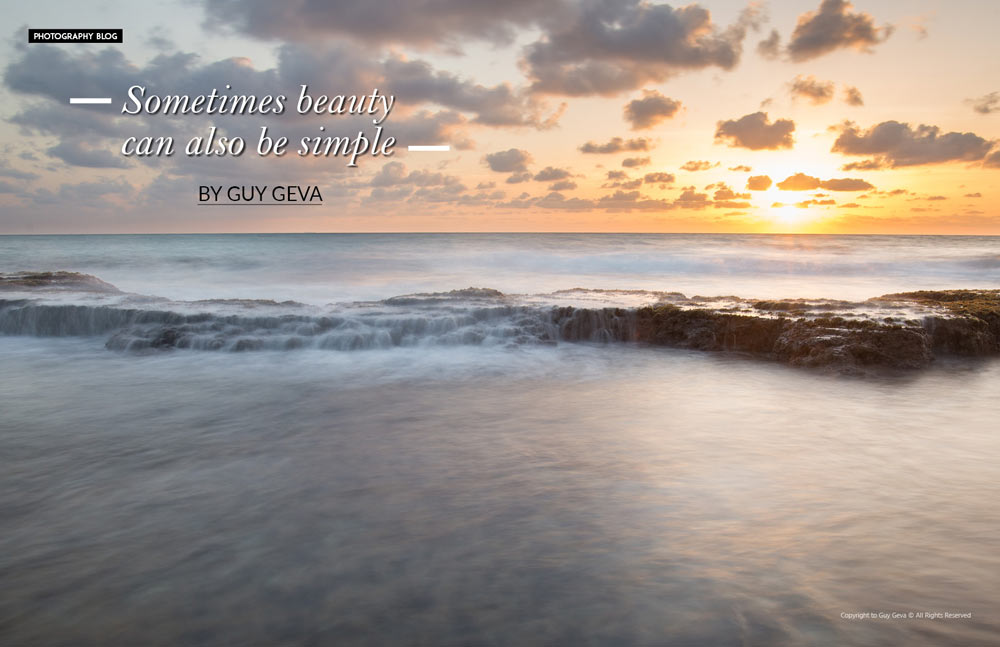– Sometimes beauty can also be simple –
BY GUY GEVA

Copyright to Guy Geva © All Rights Reserved
It seems that the world of photography today aspires to perfection, especially regarding landscape photography. I do not know if the manufacturers are the ones who started the revolution or the photographers created the demand for it (and the producers will line up with the desire for “perfect” equipment) or maybe it’s done in parallel. In any case, whoever will be the first to start this race – the result is already here, and today manufacturers are in an increasing effort to produce the perfect equipment. Whether it’s a camera body with an increasing amount of megapixels that produce ever-increasing dynamic ranges and processors that allow to shoot at a high ISO and at the same time keep the image smooth and clear of noise and at the same time as small details as possible. The lenses also underwent optical progression and are of unprecedented quality. Companies such as Zeiss, for example, produce lenses that can almost eliminate distortions in the image even in wide-angle lenses or lenses that eliminate unwanted flares in the image and produce contrasts and amazing resolutions.
Landscape photography strives for perfection. Manufacturers and, of course, photographers try to create the perfect picture, which does not exist at all in reality. Landscape photographers are now dealing much more than ever in HDR photography even if it will not be more realistic. Such as taking sunset photos with rocks in the sea, although it may not be rocks without any shadow or dark sections while the sun is low in the sky. The whole picture will be bright when all the necessary details will stand out: the sky will not be burned (even if they are burned in reality because of the location of the sun in the sky), the colors will be so rich that it is clear to the viewer that there are no such colors in reality. Today there are filters that allow exposures of 20 stops under the existing light conditions and exposure of the waves will be so smeared that the sea can in some cases, bleach almost completely.

Copyright to Guy Geva © All Rights Reserved
In addition to that there is almost an uncompromising demand for the use of filters rated to compare the intensity of light in the sky and water. That they will be equal even if it is not possible (probably by chance using a filter that produces long exposure in a disproportionate way). But a photographer who does not meet these requirements seems to be ignorant. That’s a picture “needs” to be if not perfect, then at least on the verge of perfection at the enormous dynamic range level. Which affects the points of shadow and burning that exist in reality that all of them need to be eliminated.

Copyright to Guy Geva © All Rights Reserved
The use of as high ISO as possible was avoided as well as celestial bodies. Although there is some justice in that landscape photography usually prints in large sizes (at least most of my customers over the years are interested in large prints) but there is still room for some noise in landscape photography and sometimes even something magical. However, with today’s technology, it seems that this too is disappearing when manufacturers have started the competition to produce as many silent images as possible in ISO 12,000 or more.
The problem with high ISO in my opinion is not the “noise” created but how it looks. The sensor consists of pixels that in high ISO, you can see how the picture is made up of a collection of squares. While in the period of films the salt grains were random in shape so that the “noise” would seem more “natural” and pleasant to the eye thanks to the different forms of the grains of salt.

Copyright to Guy Geva © All Rights Reserved
In an attempt to create the perfect landscape, there is a desire to change reality so that it fits the ideal of beauty that does not exist anywhere. Like models that are far above “human beauty” thanks to image processing software. This is also true of the “plastic” landscape photography of magical sunsets that do not exist in such a high frequency and everywhere, and therefore intensify landscape photography far above reality by increasing the intensity of color in computer programs and using filters that extend the exposure times far beyond the possible reality.
In any case, in many cases the landscape is as beautiful as it is. Without the “milk water”. But with a sun that burns the sky. A stream we reach is flowing with a slight noise that cannot always be seen when it is taken with exposure-blocking filters. The ripples of the water can produce interesting shapes and reflections that, without spreading them, can give the spectator the possibility of understanding how the place would look and what was beautiful in it.

